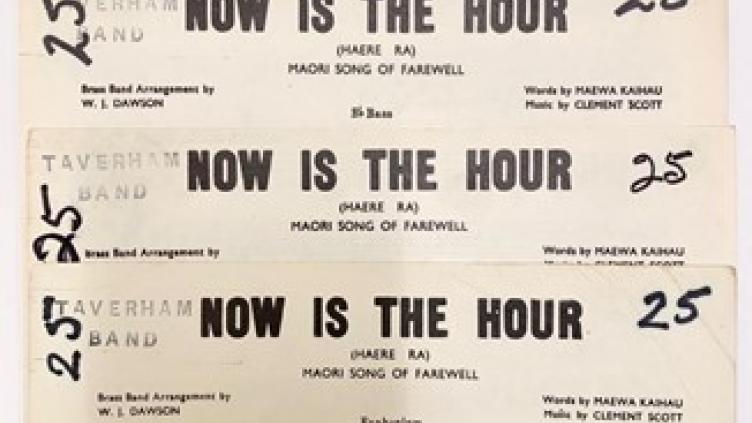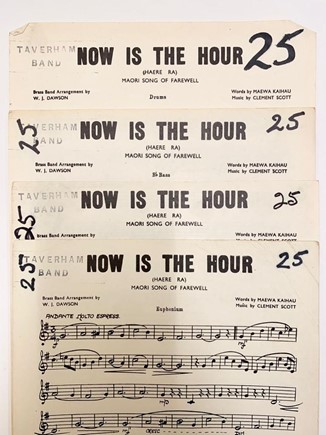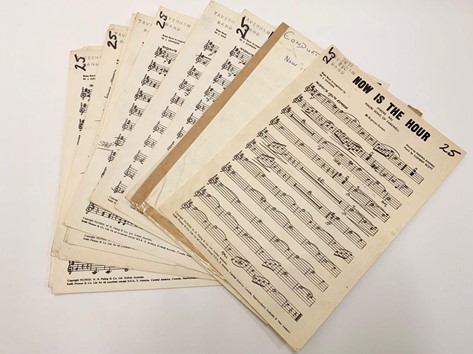You can become a member of BBE either as an organisation or as an individual

Last year, Brass Bands England (BBE) delved into the Brass Bands Archive (BBA)- a vast array of sheet music and brass band memorabilia, accumulated over the past 50 years.
A project led by a team of archivists and volunteers is currently underway to organise the collection, ensure its preservation for the future, and improve its accessibility to researchers, brass band enthusiasts, and the general public.
Volunteering for BBE is a rewarding experience, particularly when in researching specific pieces of music held in the archive, one finds a mystery. A recent case: the weekly spreadsheet I was working through to find composer dates included the names Clement Scott and Maewa Kaihau. This was in relation to the brass band arrangement of Now is the Hour. Their dates were easy to find, but the request led me down a rabbit hole of intrigue and copyright debate as I googled my way to the information.
Not only is there much more to the song-title than meets the eye, but I was introduced to a fascinating Maōri woman, also known as Emira, who inspired me to write this blog because of my own interest, as a musician and former radio presenter, in women composers.
It was Women’s History month when I started, which also opens a conversation about how much musicians know about the pieces they play, and how many assumptions are made when composer names are presented as initials. For instance, “M. Kaihau” could be anyone, and add to that the rich output of ‘anonymous’…
Relating this to the archive, how many under-represented groups are hidden within its brass band music collection? In this case, the song’s popularity during the first world war muddied the waters relating to its origins and evolution, leading to one complete case of mistaken identity and one person credited for lyrics she only partially contributed, but who was an excellent musician and composer in her own right.
Three Titles, Two Time Signatures, but only One Tune
The brass band version of Now is the Hour, was arranged by W. J. Dawson, a pseudonym for William James Duthoit. The other titles, Haere Ra and Maori Song of Farewell, echo the tune’s roots and historical function and, just as there are three of these, there are also three protagonists in this story: Duthoit, Kauhai and Clement.
Born in London in 1885, Duthoit, also known as “Dusty”, arranged an enormous amount of music from his time in the army (1902-1920) through his appointment as bandmaster of the 2nd Battalion Staffordshire Regiment (1923-1929).
He became chief arranger for the Chappell Army Journal from 1938 until his retirement in 1964. He died a year later. Many of his arrangements, like Now is the Hour, were from popular standards and Broadway shows.

Duthoit is a contemporary of Maewa Kaihau although I doubt they met. Daily Telegraph journalist, Clement Scott, was a generation older – born in 1842, he died two years after Duthoit joined the army, in 1904. And this is where the mystery comes to life.
According to Philip Scowcroft in his 206th Garland of British Composers, Scott based his popular tune on a traditional Maōri melody which he had heard during a visit to New Zealand, to which he then added lyrics.
Like Scowcroft, my mother remembers the song being sung by Gracie Fields (a neighbour of hers during wartime London) after Gracie’s visit to New Zealand in 1945; however, it was originally published by W. H. Paling & Co. (Australia) as a piano piece in common time (4/4) called Swiss Cradle Song, credited to Scott in 1913.
If you look at the copy of Now is the Hour, held by BBE, you will see it is in waltz time (3/4) but is still marked copyright 1913 to W. H. Paling & Co. in Sydney. This change of time signature could be very important in copyright terms because it changes the nature of the tune.
The Clement Scott Mystery
Did the journalist Scott really visit New Zealand [Aotearoa], and did he hear the melody there?
It is confirmed that Scott was something of a travel writer, so it is possible he went to the Antipodes; however, there is no evidence of this.
There are some fascinating options for the second question. Since the piano piece was used to accompany silent movies being played in southern hemisphere cinemas at the time, and since there is no evidence that Scott was musical (although this was the golden age of the parlour piano, where almost everyone could tickle the ivories), it seems unlikely that the Clement Scott in question was from the UK.
This doubt feeds into a strong claim by an Australian family that the tune was originally written by piano teacher, Albert Bokhare Saunders in 1910, published under one of Saunders’ many pseudonyms – Clement Scott. Palings published a range of the Australian Scott’s 300 compositions.
This is further supported when, after Bing Crosby’s version entered the charts in February 1948 (his 42nd and last single), Time magazine reported:
"Everybody else was singing [the song] before Americans even heard of it. It began 35 years ago as the Swiss Cradle Song, written by an Australian. Then a Maori woman, who liked the tune made up some words to go with it, sang it at a Maori festival. The natives picked it up; so did white New Zealanders who mistakenly thought it an old Maori folksong. Then England's Gracie Fields got hold of it. By now it had new lyrics and a new title: ‘Now Is the Hour’. Her brassy-voiced music-hall record of the catchy, draggy tune has been No. 1 on England's hit parade for 23 weeks. London Records decided that the song was just what they were looking for to crash the rich U.S. record market. Last week 24,000 records (weighing six tons) of Gracie Field’s version arrived in Manhattan, the biggest shipment of foreign records ever to hit the U.S. Gracie wouldn't have the place to herself. Bing Crosby, Kate Smith and Eddy Howard all managed to put the song on records before Jimmy Petrillo, by putting a stop to all U.S. recording, got off his own variation on ‘Now Is the Hour’".
Saunders’ family claimed copyright ownership in the equity court in 1952 but unfortunately, while the judge believed their claim to be true, he could not accept anecdotal evidence and dismissed the case. The family didn’t have the funds to continue fighting, but it appears that Saunders is a more likely candidate for the Clement Scott noted on the BBE sheet music.
Looking at the brass band edition again, Maōri Farewell specifically refers to the waltz version, more correctly known as Po Atarau. This was used during WWI when the combined Australian and New Zealand Anzac regiments were sent to war. It became New Zealand’s first million selling song.
A Royal Legacy – a Woman of her Culture
Finding out more about Maewa Kaihau, listed as composer/arranger in the BBA catalogue, busts another myth that she was associated with the wartime version, but brings to life a rich and interesting person.
Born Louisa Flavell in 1879 in Whangaroa, Northland, Kaihau was the daughter of Mary (née Downes) and William Flavell. Mary Downes was a direct descendent of an important Nga Puhi chief.
Both Kaihau’s father and the brass band arranger, Duthoit are descended from Huguenots who fled France (to New Zealand and Britain). Her father’s side also included a musician from the court of Joseph II of Austria who probably rubbed shoulders with Mozart and Salieri; this may have enhanced her natural musical abilities.
I am not sure when Louise Flavell took the name of her Maōri birthright – a photograph of her as a young woman in traditional dress can be seen at Auckland Library, when she became the second wife of Henare Kaihau in 1903.
He was the Maōri Member of Parliament representing Western Maōri until his death in 1920. She married Charles “Ned” Molesworth later that same year and kept her indigenous name presumably because, by this point, Maewa Kaihau was the name under which her many compositions and poems were published. However, looking at an article about Po Atarau/Haere Ra, it does appear that Kaihau came to the copyright party slightly later than some sources believe, in 1928.
As a child, Kaihau was taught to compose, play piano and sing. As an adult, she taught music, and was a well-respected arranger/composer, so the Times declaration that she was just some woman who heard a tune and liked it, is a little disparaging. Maōri poetry has a specific name: “waiata”, which literally means song. Traditionally, waiata would be sung or chanted with musical rhythms, making it distinct from prose.
So, in 1920, when Kaihau wrote a new verse for Po Atarau, you can understand copyright law not making the distinction between lyrics or music, whether an amendment to the original or a variation on a theme, but in fact, this version was written specifically for a private family reason.
When the Prince of Wales’ visited in 1920, Kaihau’s eldest daughter had been part of a group of girls in piupiu who had entertained the guests at a ball in Rotorua and had fallen for one of the entourage members. Unfortunately, the young man had to leave with his Prince, and Kaihau wrote this variation, with traditional embellishments, as a solace for her daughter. It was published privately with English and Maōri words.
Here, the tune has been transcribed by John Archer, creator of New Zealand Folksong:
"This is the hour, for us to say goodbye.
Soon you'll be sailing far across the sea.
Do not forget but remember me.
When you return, you'll find me waiting here."

The Copyright Conundrum – Who owns a Song?
It is to the National Library of New Zealand that one must go, in person, to delve deeper into the mystery of who ‘owns’ this piece. A quick search of the catalogue for Kaihau brings up a wealth of papers relating to copyright renewals, disputes, and assignments. The main listing credits her as “adapter of music and writer of Maōri words for Now is the Hour.”
It appears the name Now is the Hour was not used until in 1935, when a hybrid version of the song was published bringing together Kaihau’s verse above with a verse from a hymn called Ratana (1925), and verse 3 of Po Atarau (1915). Verse one was in English while verses two and three were in Maōri with English alternatives.
In the words of John Archer: “Kaihau’s genius was to mold a version whose words could be understood and appreciated by both Maori and British communities” – this has evolved into arrangements of the song available all over the world.
Palings were quick to claim copyright of any version of the tune regardless of time signature, and Kaihau’s words were copyrighted in 1928 by Robertson’s Publishers; the BBA arrangement is under copyright to Keith Prowse & Co. for all countries except those in the Americas and Antipodes, but still notes W. H. Paling & Co’s 1913 copyright ownership which takes us right back to the original piano composition with an entirely different name.

The Last Waltz
Now is the Hour is delightful enough to be popular without words and over the years, it has become a favourite last dance, a farewell to troops and to friends embarking on journeys, and it has been recorded by people well known worldwide as well as those local to New Zealand.
As far as the BBA arrangement goes, it has a role to play in shining a little spotlight on several fronts: Maewa Kaihau [Louisa Flavell] is confirmed in the increasing inventories of women composers, and we can hope the disputed Clement Scott [Saunders] issue may have a happy ending as social media, as well as increasing access to archival sources, helps the copyright fight in the 21st century.
That the Dawson [Duthoit] brass band arrangement exists, and that this is held by Brass Bands England, proves the piece enjoyed a British following. While it does not appear to have been used in band competitions, it kept its place in village life and special occasions – possibly all the sweeter for that.
I hope I have been able to illuminate a few of the key individuals involved in making this piece as popular as it is, even if I didn’t solve the copyright conundrum today.
Written by Rasma Bertz, Brass Bands Archive Volunteer

The Future of the Brass Bands Archive
The current project is just another stage in the life of the Brass Bands Archive.
In the long-term, we are hoping to undertake a large-scale digitisation project, which will improve access to the sheet music library. We are also planning to undertake outreach (such as exhibitions and lectures) to provide educational opportunities and enable greater engagement with the Brass Bands Archive.
As the collection undergoes a cataloguing process, it will become more accessible to a greater number of people and be available for use by the banding community, researchers, family historians and anyone who is interested in the history of brass bands.
If you’ve read this far, you must be as enthusiastic about brass band history as we are. Here’s how you can stay involved in the project:
Register your interest in visiting the Archive at its new residence in Heritage Quay later this year.
Email us at info@bbe.org.uk about volunteering at the Archive.
Discover more about the Brass Bands Archive in our #Archive30 Twitter thread.
See images of objects from the Archive on the Brass Bands England Instagram.